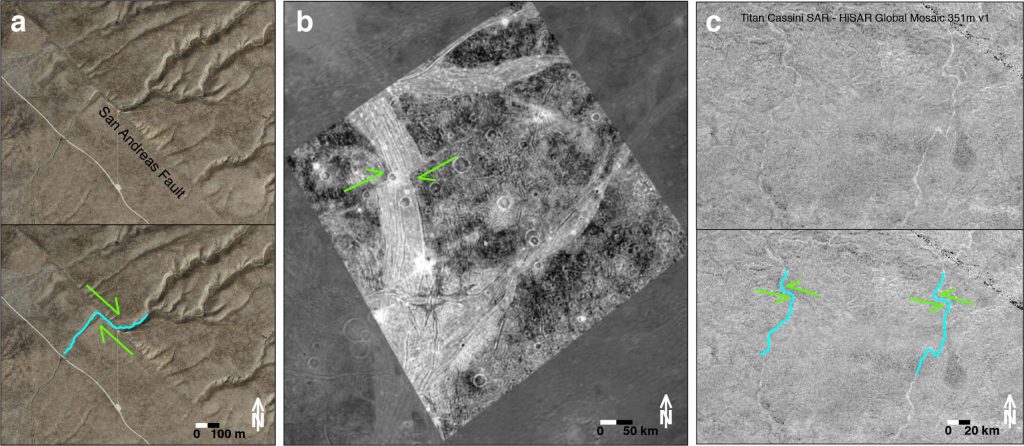Supporting the search for alien life by exploring geologic faulting on icy moons
Two recently published studies led by University of Hawai‘i at Mānoa earth and space scientists document and reveal the mechanisms behind strike-slip faults on two icy moons within our solar system — Titan, the largest moon of Saturn, and Jupiter’s largest moon Ganymede — that could help create the right conditions for life.

When an icy moon moves around its parent planet, the gravity of the planet can exert tidal forces.
Rather than creating high and low tides like Earth’s ocean, on these frigid moons, where the ice acts as rock that can crack, fault and deform, tidal pull puts stress on the surface and can drive geologic activity such as strike-slip faulting.
“We are interested in studying these features on icy moons because that type of faulting can facilitate the exchange of surface and subsurface materials through heating processes, potentially creating environments conducive for the emergence of life,” said Liliane Burkhard, lead author of the studies and research affiliate at the Hawai‘i Institute of Geophysics and Planetology of the UH-Mānoa School of Ocean and Earth Science and Technology.
Scientists have documented strike-slip faults, which happen when fault walls in the ground’s crust move past one another sideways as is the case with California’s San Andreas fault, on the surface of many of the solar system’s icy moons.

While water freezes on the extremely cold surface of Titan, evidence from the Cassini spacecraft suggests that tens of miles below there is a liquid water ocean.
Titan also is the only moon in our solar system with a dense atmosphere, which uniquely supports an Earth-like hydrological cycle of methane clouds, rain and liquid flowing across the surface to fill lakes and seas, placing it among a handful of worlds that could potentially contain habitable environments.
The NASA Dragonfly mission will launch in 2027, with a planned arrival on Titan in 2034. The novel rotorcraft lander will conduct several flights on the surface, exploring a variety of locations to search for the building blocks and signs of life.
In their investigation of the Selk crater area on Titan, the designated initial landing site for the Dragonfly mission, Burkhard and her co-author explored the potential for strike-slip faulting by calculating the stress that would be exerted on the moon’s surface because of tidal forces as it orbits Saturn. They also examined various characteristics of the frozen ground.
In a second recently published study, Burkhard and her colleagues examined the geology of Ganymede to investigate its history with tidal stress. In particular, the team looked at a region called Nippur Philus Sulci, where new terrain overlays older terrain.
During the investigation of intermediate and younger parts of the area, the team found the direction of their slip features to have different alignments suggesting that features in the youngest terrains might have formed through processes other than high tidal stress.
“We can conclude that Ganymede has had a tidal ‘midlife crisis,’ but it’s youngest ‘crisis’ remains enigmatic,” Burkhard added.






